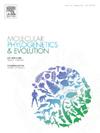黄芪科(Astragalus sect.Caprini是一个复杂的群体,包括干旱草原上的高度濒危物种。
IF 3.6
1区 生物学
Q2 BIOCHEMISTRY & MOLECULAR BIOLOGY
引用次数: 0
摘要
欧亚大草原是地球上面积最大、受威胁最严重的生物群落之一。在更新世的寒冷时期,欧亚草原地带的范围比间冰期大得多,并一再扩展到今天温带欧洲森林覆盖的大片地区。相反,在温暖时期,森林的扩张经常迫使欧亚大草原生物群进入不连续性的小型温暖阶段避难所,即今天的地带外大草原。稀有、濒危和分布不均的西北非和欧洲黄芪科成员,构成了一个理想的黄芪研究模式。Caprini 是了解典型草原生物群进化动态的理想模型。在这里,我们根据黄芪科(Astragalus sect.这里,我们结合 RADseq 数据、单基因标记(内部转录间隔、质体 ycf1)、基因组大小测量和多元形态计量学,重建了非洲西北部和欧洲黄芪科成员的时空多样性。我们勾勒出这样一种进化情景:该类群起源于伊朗-都兰地区,在中更新世过渡(约 0.5 至 0.7 马年)后不久开始分化。发生在(亚)地中海山脉的世系分化较早,而发生在北部低地草原的世系分化则要年轻得多(约 0.2 至 0.3 Ma),这强调了南欧山脉作为长期避难所的重要性。地中海东部各系对地中海西部地区的反复殖民以及目前在空间上相互隔离的各系之间的二次接触极大地(共同)塑造了该类群的遗传结构;我们认为这些事件可能是寒冷阶段范围扩张的结果。根据遗传学和形态计量学的综合数据,我们建议将本研究中引入的 10 个品系视为独立的物种,与之前的分类学处理方法形成对比。本文章由计算机程序翻译,如有差异,请以英文原文为准。

Evolution, range formation and a revised taxonomy of the disjunctly distributed European members of Astragalus sect. Caprini, an intricate group including highly endangered species of dry grasslands
The Eurasian steppes are among the largest and most threatened biomes on Earth. During cold periods of the Pleistocene, the zonal Eurasian steppes had a much larger extent as compared to interglacial periods, and repeatedly expanded into large areas of present-day forested temperate Europe. Conversely, during warm periods, forest expansion recurrently forced Eurasian steppe biota into disjunct and small warm-stage refugia, i.e. today’s extrazonal steppes. The rare, threatened and disjunctly distributed northwestern African and European members of Astragalus sect. Caprini constitute an ideal model for gaining insights into the evolutionary dynamics of typical steppe biota. Here, we reconstructed the spatiotemporal diversification of northwestern African and European members of Astragalus sect. Caprini based on a combination of RADseq data, single gene markers (internal transcribed spacer, plastid ycf1), genome size measurements and multivariate morphometrics. We outline an evolutionary scenario in which the group originated in the Irano-Turanian region and started to diversify shortly after the Mid-Pleistocene-Transition (ca. 0.5 to 0.7 Ma). While lineages occurring in (sub-)mediterranean mountain ranges diverged early, lineages occurring in northern lowland steppes are much younger (ca. 0.2 to 0.3 Ma), emphasizing the importance of southern European mountain ranges as long-term refugia. Recurrent colonization of the western Mediterranean region by eastern Mediterranean lineages and secondary contacts of currently spatially isolated lineages have significantly (co-)shaped the genetic structure within the group; we assume that these events may be a consequence of cold-stage range expansions. Based on combined genetic and morphometric data, we suggest treating the ten lineages introduced in this study as independent species, contrasting previous taxonomic treatments.
求助全文
通过发布文献求助,成功后即可免费获取论文全文。
去求助
来源期刊
CiteScore
7.50
自引率
7.30%
发文量
249
审稿时长
7.5 months
期刊介绍:
Molecular Phylogenetics and Evolution is dedicated to bringing Darwin''s dream within grasp - to "have fairly true genealogical trees of each great kingdom of Nature." The journal provides a forum for molecular studies that advance our understanding of phylogeny and evolution, further the development of phylogenetically more accurate taxonomic classifications, and ultimately bring a unified classification for all the ramifying lines of life. Phylogeographic studies will be considered for publication if they offer EXCEPTIONAL theoretical or empirical advances.

 求助内容:
求助内容: 应助结果提醒方式:
应助结果提醒方式:


